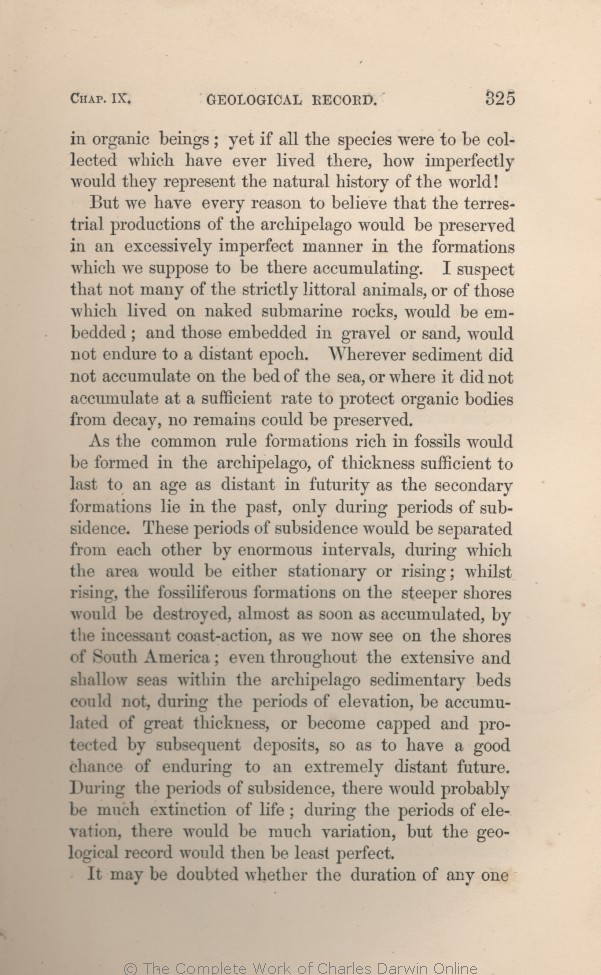But we have every reason to believe that the terrestrial productions of the archipelago would be preserved in an
excessively | excessively 1859 1860 1861 1866 | | extremely 1869 1872 |
| I suspect that not 1859 1860 1861 1866 |
| Not 1869 1872 |
| sand, 1859 1860 1861 | | sand 1866 1869 1872 |
| epoch. 1859 1860 1861 1866 1869 |
| epoch. Wherever sediment did not accumulate on the bed of the sea, or where it did not accumulate at a sufficient rate to protect organic bodies from decay, no remains could be preserved. 1872 |
| accumulate 1859 1860 1861 1866 | | accu- mulate 1869 |
|
As the common rule formations rich in fossils would be formed in the archipelago, of thickness sufficient | As the common rule formations rich in fossils would be formed in the archipelago, of thickness sufficient 1861 |
| In our archipelago, I believe that fossiliferous formations could be formed of sufficient thickness 1859 |
| I believe that fossiliferous formations could be formed in the archipelago, of thickness sufficient 1860 |
| Formations rich in fossils, and of thickness sufficient 1866 |
| Formations rich in fossils of many kinds, and of thickness sufficient 1869 1872 |
| age 1860 1861 1866 1869 1872 | | age, 1859 |
| only 1859 1860 1861 |
| would generally be formed in the archipelago only 1866 1869 1872 |
| enormous 1859 1860 1861 1866 | | immense 1869 1872 |
| intervals, 1859 1860 1861 | | intervals 1866 1869 1872 |
| during 1859 1860 1861 |
| of time, during 1866 1869 1872 |
| the 1861 1866 1869 1872 | | each 1859 1860 |
| formations 1861 1866 1869 1872 | | formation 1859 1860 |
| on the steeper shores would 1861 1866 1869 1872 |
| would 1859 1860 |
| America; even throughout the extensive and shallow seas within the archipelago sedimentary beds could not, during the periods of elevation, be accumulated of great thickness, or become capped and protected by subsequent deposits, so as to have a good chance of enduring to an extremely distant future. 1861 1866 |
| America. 1859 1860 1872 |
| America; even throughout the extensive and shallow seas within the archipelago sedimentary beds could hardly be accumulated of great thickness during the periods of elevation, or become capped and protected by subsequent deposits, so as to have a good chance of enduring to a very distant future. 1869 |
| 1 blocks not present in 1859 1860 1861 1866 1869; present in 1872 | | Even throughout the extensive and shallow seas within the archipelago, sedimentary beds could hardly be accumulated of great thickness during the periods of elevation, or become capped and protected by subsequent deposits, so as to have a good chance of enduring to a very distant future.
|
| subsidence, 1861 1866 1869 1872 | | subsidence 1859 1860 |
| least 1859 1860 1861 1866 1869 | | less 1872 |
|









